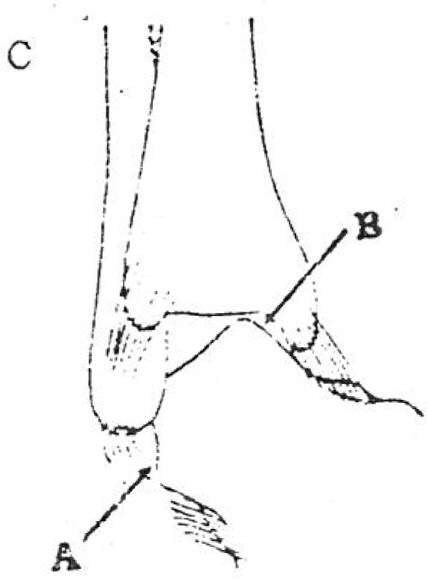J Korean Orthop Assoc.
1974 Jun;9(2):198-208. 10.4055/jkoa.1974.9.2.198.
Clinical Study of the Ankle Fracture
- Affiliations
-
- 1Department of Orthopedic Surgery, Kyungpook National University School of Medicine, Taegu, Korea.
- KMID: 2471504
- DOI: http://doi.org/10.4055/jkoa.1974.9.2.198
Abstract
- One hundred and twenty three cases of the ankle fracture have been treated and managed in the Department of Orthopedic Surgery, Kyungpook University Hospital during the period from January. 1968 to December, 1573. One hundred and twenty three patients were analyzed clinically according to Lauge-Hansen and Ashhurst-Bromer classification and results obtained were as follow. 1. The causes of ankle fractures were mostly due to automobile accident (61%). 2. The incidence of trauma was in the young man, most frequent in 3rd decade. 3. In classification of our materials according to Lauge-Hansen and Ashhurst-Bromer, the type of lateral rotation is most common type in this series and the stage II of lateral rotation is more common than other stages. 4. The average duration of cost Immobilization is 10.1 weeks after closed reduction was performed, and 8.2 weeks after open reduction. 5. Anatomical reduction was obtained in 99 patients (80.4%) and good objective clinical results in 74%. 6. The quality of clinical results depends mostly on the accuracy of the reduction, to a lesser extent on the degree of initial displacements, and least on the type of fracture and age of patient.
MeSH Terms
Figure
Reference
-
1. Ashhurst A.P.C., Bromer R.S.Classification and Mechanism of the Fracture of the Legs Involving the Ankle. Arch. Surg. 4:51. 1922.2. Injury to the Ligaments of the Ankle. J. Bone J. Surg. 47-B:609. 1965.3. Burgress E.Fractures of the Ankle. J. Bone J.Surg. 26:721. 1944.4. Burwell H.N., Charnley A.D.The Treatment of Displaced Fracture at the Ankle by Rigid Internal Fixation and Early Joint Movement. J. Bone J. Surg. 47-B:634. 1965.5. Cedell C.A.Outward Rotation-Supination Injuries of the Ankle. Clin. Orthop. 42:97. 1965.6. Close J.R.Some Applications of the Functional Anatomy of the Akle Joint. J. Bone J. Surg. 38-A:761. 1956.7. Cox F.J., Laxson W.W.Fractures About the Ankle Joint. Am. J. Surg. 83:674. 1952.
Article8. Colton C.L.The Treatment of J. Dupuytren's Fracture-Dislocation of the Ankle. J. Bone J. Surg. 53-B:63–71. 1971.9. Denham R.A.Internal Fixation for Unstable Ankle Fractures. J. Bone J. Surg. 46-B:206. 1964.
Article10. Harvey J.P.Fracture of the Ankle. Clin. Orthop. 42:57. 1965.11. Kleiger B.The Mechanism of Ankle Injuries. J. Bone J. Surg. 38-A:59. 1956.
Article12. Kleiger B.The Treatment of Oblique Fracture of the Fibula. J. Bone J. Surg. 43-A:969. 1961.13. Fracture of the Ankle. Combined Experimental-Surgical and Experimental Roentgenologic Investigation. Arch. Surg. 60:975–958. 1956.14. Meyers M.H.Fracture about the Ankle Joint with Fixed Displacement of the Proximal Fragment of the Fibula behind the Tibia. J. Bone J.Surg. 39-A:441. 1957.
Article15. Quigley T.B.Fractures and Ligament Injuries of the Ankle. Am, J. Surg. 98:477. 1959.
Article16. Shephard E.Tarsal Movements. J. Bone J. Surg. 33-B:258. 1951.
Article17. Wade P.A.The Operative Treatment of Fracture-Dislocation of the Ankle. Clin. Orthop. 42:37. 1965.








